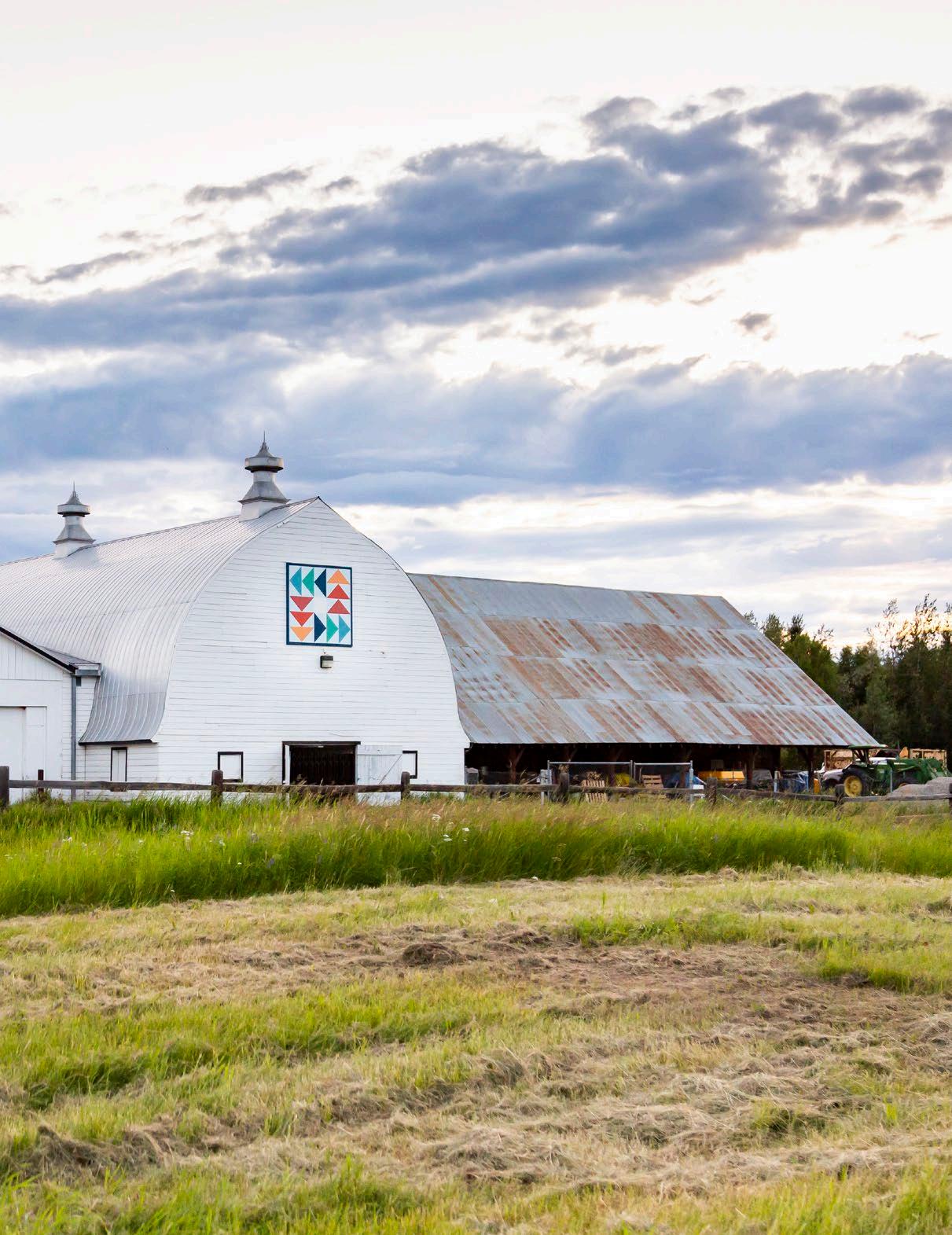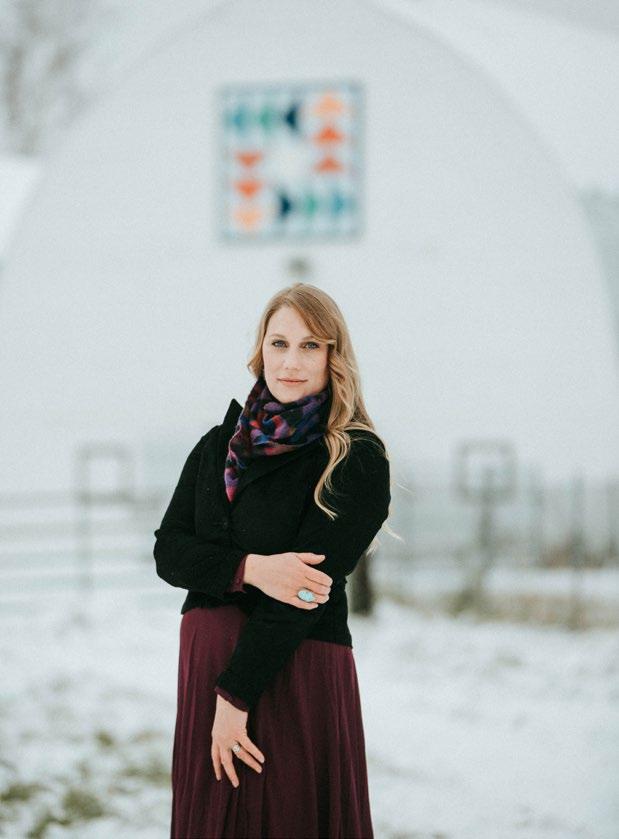
10 minute read
Piecing It Together
Somer Hahm and the Far North Quilt Trail by Addie Studebaker
When thinking of a hand-sewn quilt, you might think of grandmas, aunts; family heirlooms passed down. A feeling of hominess, coziness, comfort, caretaking; a sense of the old-fashioned juxtaposed with timelessness. Quilts are ubiquitous across several cultures, but at the same time incredibly personal and unique to the individual creators, with the designs tailored to their specific experiences and heritages and even becoming historical records and artifacts over time. Somer Hahm of Fairbanks, Alaska, has dialed into all of these themes in her eyecatching geometric quilt paintings, part of a larger project, The Far North Quilt Trail Project. Though the project is rooted in her home community of Fairbanks, it is now gaining traction and visibility statewide, joining a number of established quilt trails in the Lower 48 and Canada.
Advertisement
Barn quilts and self-guided “quilt trails” began and first took off in Ohio in the early 2000s and it works like this: Colorful geometric patterns reminiscent of hand-sewn quilts are painted on large wooden squares. Those painted squares are placed as long-
A Flying Geese pattern at Creamer's Field Migratory Waterfowl Refuge.

Somer Hahm. Photo by Stephanie Barney

term installed artworks on the side of barns (traditionally) or other large, visible buildings and structures. When several are installed in a community, a trail of public art emerges; one that is free to the public, often accessible year-round, 24/7, and visible from the road. A recent New York Times article on barn quilts by Jackie Snow (that mentions Somer Hahm’s project, among others), sums it up as a “home-grown art form that combines a few aspects of traditional Americana: barns, quilts, and road trips.” Beyond their visibility and attractive aesthetic appeal—bold, colorful, and murallike—the artworks also proudly represent aspects of a family, organization, or even an entire region’s unique character and culture in their design; utilizing traditional quilt patterns but also experimenting with geometric representations of nature and other forms. In this way, barn quilts also celebrate the meaningful tradition of quilting itself, which, as Hahm points out, “speaks to the domestic labor that often goes unnoticed,” but also to the joy and creative expression that can exist and persist alongside it. The immediate communal benefits of this form of public art are two-fold: They both increase public interest in these lesstrafficked areas where they are installed and, in Hahm’s words, “build community around the visual language of painting—barn quilts can highlight an area not normally visited or shine a light on places that might be overlooked within a community.” Hahm offers the Fairbanks area and Interior Alaska as examples, noting that there is an increasing interest in family farms in that area engaging in sustainable agriculture for the benefit of the local community and beyond. The quilt trail serves as a highly visual way to link these locations and their shared mission and values. In terms of building community, a task that in Alaska may be both especially vital and challenging, quilt trails encourage this both in process and product. “Fairbanks is spread out, with many little offerings tucked away in our stark industrial landscape,” says Hahm. “Once I started expanding my idea of where art could live, I saw Fairbanks itself as a gallery space.” This means the art is accessible to all in the community, containing images that are hyper-local and recognizable to those both visiting and living in that community; like the “Juncos,” “Sunflower,” and “Flying Geese” painted quilts that Hahm created and installed for, with, and at the Fairbanks Community Garden and Creamer’s Field Migratory Waterfowl Refuge, respectively. The projects are highly collaborative, bringing many in the community together, from securing funding to initial design to installation and even celebration. “This is the great strength and value of this project,” says Jess Peña, Executive Director of Fairbanks Arts Association. “Whereas some public art is commissioned and then designed and made by small teams with expensive materials, this project has community engagement at its center where the design and location decisions, implementation, and—most importantly—intentions, circle around community inclusivity.”
For her part, Hahm has lived in Fairbanks since first working toward her MFA at University of Alaska Fairbanks, which she earned in 2008. “After my undergrad in Montana, I was accepted into several graduate programs but was offered a teaching assistantship from UAF, so I moved to Fairbanks in 2005 without ever having set foot in Alaska before. My parents drove me and dropped me off.” During and after her graduate program she worked in various
contexts within the Fairbanks art community, and regularly painted and exhibited locally for several years before her daughter was born. The idea of initiating a quilt trail in Alaska came at the pivotal point of re-entering the workforce after having her second child. She worked as an exhibition technician for the Fairbanks Arts Association, and when the association partnered with the Alaska State Council on the Arts (ASCA) to host the Interconnect Art Conference, Hahm attended. It was through this conference that she was exposed to a breadth of tools and resources available to working artists. “That weekend was life-altering for me,” Hahm says. “I learned about installing public art from Enzina Marrari of Anchorage. I took a session on how to write winning grant proposals from another Anchorage artist, Maria Shell. I had help from Keren Lowell of ASCA in building my first website. Ernestine Hayes read from her book The Tao of Raven, a most inspiring open address. Daka-Xeen Mehner, in the final keynote speech, asked us all, ‘How do arts, culture, and creativity activate networks and communities to move towards an innovative and inspired future for Alaska? What roles do each of our individual voices play in this challenge?’ The Far North Quilt Trail Project was my answer to that.” Empowered by this newfound working knowledge and contact base, she left the conference motivated and inspired to create a sustainable arts career for herself and her family. “I began asking myself, How do I gain experience in making public art? How can I make large scale paintings and get paid to do so? How can I create community around art? How can I utilize my skills to build something extraordinary? How can I expand my audience? How can I create my own opportunities to do projects that I envision?”
These questions, and the acquisition of affordable studio space for the first time— both on her property (in a brilliant silver 1954 Clipper Airstream) and off (in a guiding company’s small, dry attic apartment), depending on the season—led to time and space that had previously been inaccessible to her as a parent of two young children in Fairbanks. In these studio spaces she created a large and cohesive body of work she titled “The Painted Quilt,” expanding her portfolio and opening up her options. “Before ‘The Painted Quilt’, I painted small works and created a series of educational botanical posters for children and did this all on my kitchen table for six years,” Hahm says. She exhibited “The Painted Quilt” in 2020 at the Fairbanks Art Association’s Wandering Bear Gallery and was wellreceived, and began applying for grants. In 2020 she was awarded several grants, including a Community Arts Development Grant from the Alaska State Council of the Arts, as well as the prestigious Rasmuson Individual Artist Award. She has since partnered with many businesses and nonprofits, completing or overseeing the installation of over a dozen barn quilts across the Interior and Southcentral Alaska in 2020-21. “My kids have been with me for every installation and most of the weeks before while I’m painting, and I enjoy exposing them to the process and to my work,” Hahm says. “But motherhood has fundamentally changed my approach to making visual art.

A Rising Sun pattern at Boreal Sun Charter School. PHOTO BY SARAH MANRIQUEZ

The Folk Quilt at The Folk School located at Cabin 66 in Pioneer Park/Alaskaland. PHOTO BY SARAH MANRIQUEZ
Carving out time for the work now requires a concentrated effort in short periods of time. I’ve learned there’s no one way to be an artist.”
Philosophically, her experience as a mother-artist contributed to Hahm’s interest in painting quilts. “I do enjoy the formal elements—the patterns are templates for abstraction. Playing with color transitions is an integral part of my process. But I’m also very inspired by histories and patterns that are embedded in handmade quilts and I often try to incorporate the restraints of motherhood in my practice. Quilts speak to the domestic labor that often goes unnoticed. What does it mean to paint a quilt? I find the process of painting them to be meditative and soothing.” Hahm cites the Encyclopedia of Quilt Block Designs as another starting point for inspiration. First recommended to her by fiber artist Maria Shell of Anchorage, it contains several thousands of quilt patterns and descriptions. Hahm owns two copies of this text and lends one out to community members when they express an interest in painting a barn quilt. This highly-collaborative approach— from connecting with her local community to securing partnerships and painting sites— requires a great deal of creativity and flexibility. Each of her barn quilts is unique to the location and client, requiring “research, brainstorming, and team-building” with partnering organizations and local businesses. Hahm says some of the more challenging aspects of the process, aside from the actual art-making, have been managing the many moving parts of both the funding and installation processes, as well as undertaking the many hours of research, grant-writing, branding, and website management that includes keeping an up-to-date list of quilt trail sites on her website. If an Alaska resident is interested in painting or registering a barn quilt, they simply contact Hahm through a form on her website. Registration is free and Hahm follows up to offer support and clarification. Locations can be private residences or public buildings (with the necessary permissions) and can be placed on the public website map or simply shared through photos, with the location remaining private. “I offer advice and recommendations to community members free of charge,” Hahm says. “These helpful tidbits range from how to source and select the lumber to purchasing the appropriate materials. I’m enthusiastic about sharing my knowledge and expertise.” In addition, Hahm has been teaching workshops related to her work through Well Street Art Company and The Folk School, both in Fairbanks: “It’s my objective to grow, nurture, and cultivate renewed interest in the quilt trail over time by teaching painting workshops in which I share my techniques and invite participants to add their own works to the trail. My goal is to continue to offer the access point for my community to engage in being creative.” Looking forward, Hahm is building on her grant wins and the project’s increasing visibility, while also continuing to learn how, where, when, and who to ask for help and also how to manage rejection—two distinct areas where this endeavor has pushed her as a professional artist. More specifically, she hopes to establish a more robust relationship between UAF and the Fairbanks community through the Far North Quilt Trail Project, and is interested in exploring locations in the highly agricultural Mat-Su Valley. She also has a solo exhibition of new works that will be on display in May of 2022 at Well Street Art Company. “My proposals are grounded in listening and utilizing visual art to create connections in my community,” Hahm reflects. “Growing and nurturing the quilt trail enriches my professional development by requiring collaboration from the participants and, in turn, fostering positive working relationships between myself, other artists, art enthusiasts, and the broader community.” It’s a path—a trail—that will be exciting to watch. ■
Addie Studebaker is a writer, artist, and English professor in the Mat-Su Valley. Find her at www.whatamilookingatt.com or connect on Instagram @whatamilookingatt.





